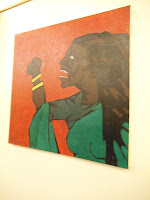 The
newly released biography Vamona Navelcar:
An Artist of Three Continents, published by Reality PLC Pune with the
support of Village Sanctuary Arts, is as much about the life of a Goan artist as
it is about interrelated histories within Goa’s geography and beyond. Anne
Ketteringham, the author, a retired British aeronautical engineer and birdlife
photographer, attended the April release of her book at Fontainhas’ Gitanjali
Gallery where a retrospective of Vamona Ananta Sinai Navelcar’s art was on
display. The now octogenarian’s eclecticism is apparent in the multitude of
styles he employs, from line drawing to painting, that match equally varied
themes, including religious iconography, contemporary issues, and cityscapes as
could be seen in the exhibition. Navelcar, also in attendance, had little to
say, but there was a palpable sense of the meaningfulness of this belated
recognition in his own homeland. His biographer noted the difficulties of her writerly
task, which included researching Navelcar’s life and dealing with her sometimes
reticent subject. Ketteringham spoke of the inevitability of miscommunication
during the process as she is “hard of hearing and Vamona is a soft-spoken man.”
This conjures up an image of silent pauses full of intense meaning which, along
with the theme of miscommunication, aptly characterises Navelcar’s life as the
book represents it.
The
newly released biography Vamona Navelcar:
An Artist of Three Continents, published by Reality PLC Pune with the
support of Village Sanctuary Arts, is as much about the life of a Goan artist as
it is about interrelated histories within Goa’s geography and beyond. Anne
Ketteringham, the author, a retired British aeronautical engineer and birdlife
photographer, attended the April release of her book at Fontainhas’ Gitanjali
Gallery where a retrospective of Vamona Ananta Sinai Navelcar’s art was on
display. The now octogenarian’s eclecticism is apparent in the multitude of
styles he employs, from line drawing to painting, that match equally varied
themes, including religious iconography, contemporary issues, and cityscapes as
could be seen in the exhibition. Navelcar, also in attendance, had little to
say, but there was a palpable sense of the meaningfulness of this belated
recognition in his own homeland. His biographer noted the difficulties of her writerly
task, which included researching Navelcar’s life and dealing with her sometimes
reticent subject. Ketteringham spoke of the inevitability of miscommunication
during the process as she is “hard of hearing and Vamona is a soft-spoken man.”
This conjures up an image of silent pauses full of intense meaning which, along
with the theme of miscommunication, aptly characterises Navelcar’s life as the
book represents it.  Ketteringham’s
text chronicles Navelcar’s life story and his evolution as an artist who was
affected by such historical events as Goa’s decolonization, Mozambique’s
freedom from the Portuguese and its post-independence struggles, as well as the
Carnation Revolution which ended Portugal’s Estado
Novo. In 1950s and 60s Lisbon, Navelcar was a starving student. His art
scholarship had been temporarily revoked, allegedly due to his refusal to
become embroiled in Goan diaspora politics. Throughout the text, Navelcar’s avoidance
of thinking of himself as being political is highlighted, but the events of his
life prove otherwise. If not always through his own direct participation, it
would appear that Navelcar was embroiled in political goings-on that were of
national and even international import. A case in point is the scholarship the
then young artist received to study in Lisbon, which was bestowed, as the book
informs, “by the prime minister of Portugal” himself – one Dr. António de
Oliveira Salazar. Conjecture might allow that this was a propaganda move on the
part of the Portuguese dictator, especially as it came in the years following
India’s independence from the British.
Ketteringham’s
text chronicles Navelcar’s life story and his evolution as an artist who was
affected by such historical events as Goa’s decolonization, Mozambique’s
freedom from the Portuguese and its post-independence struggles, as well as the
Carnation Revolution which ended Portugal’s Estado
Novo. In 1950s and 60s Lisbon, Navelcar was a starving student. His art
scholarship had been temporarily revoked, allegedly due to his refusal to
become embroiled in Goan diaspora politics. Throughout the text, Navelcar’s avoidance
of thinking of himself as being political is highlighted, but the events of his
life prove otherwise. If not always through his own direct participation, it
would appear that Navelcar was embroiled in political goings-on that were of
national and even international import. A case in point is the scholarship the
then young artist received to study in Lisbon, which was bestowed, as the book
informs, “by the prime minister of Portugal” himself – one Dr. António de
Oliveira Salazar. Conjecture might allow that this was a propaganda move on the
part of the Portuguese dictator, especially as it came in the years following
India’s independence from the British.
As
a teacher in 1970s Mozambique, despite his artistic support of anti-colonialism,
Navelcar was hauled off
to a “rehabilitation camp.” Though offered release, he
would not leave without his students. The artist’s diasporic history raises
interesting questions about the nature of Goan immigration through colonial
networks. While there has been some scholarship on the movement of Goans
between Portuguese and British India and, from there, to other British
colonies, how might the picture be seen differently through the lens of
migrations via Portuguese territories themselves?
Deeply
hurt by his experience in Africa, Navelcar returned to Portugal when,
tragically, much of his art disappeared en route. The lack of opportunities in
post-Estado Novo Lisbon had Navelcar
make his way back to Goa where he has lived an exilic life in his native land. Ketteringham’s
book and the retrospective are important steps in bearing witness to Navelcar’s
legacy while he still lives. Though the biography could have benefitted from
better editing and a sustained critical perspective, it speaks to a Goan identity
hewn beyond its own boundaries and the significance of an artist capable of
painting that complex picture.
The print version of this article can be seen online.










